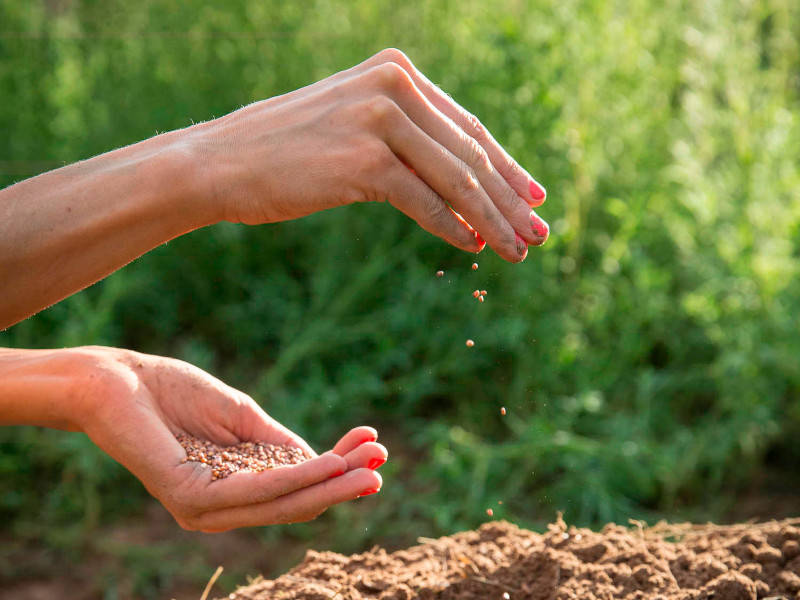Sometimes I sit with my elbows on my kitchen counter and stare at the red cabbage sprouts. I look closer until I find new ones that have poked through the soil, wearing their husks like a hat. Their spicy funk—the same compound that makes wasabi hot—tickles my nostrils.
I wonder if my restaurants will be open when they grow up.
My garage is full of discarded junk and paperwork from the six restaurants I’ve opened over the last twelve years. I keep meaning to sort through it, but end up skulking around the edges, pulling out odds and ends I can use in the garden, or to start more of the seeds that are covering my kitchen table.
One morning, I find two jugs, the kind used for growlers of beer. I tote them around with me to water the seeds I’ve tucked in secret spots in the garden so I don’t have to lug a hose. My special talent is tying hoses in knots.
I have to get my face almost to the dirt to see if my sunflowers have germinated. I’m close enough to see a red ant hauling a piece of straw, lilting and swaying over dimples and hillocks; close enough to see a snail, shell speckled like the skin of a rattlesnake. A line of green goosenecks appears—where I swear I had already looked—sunflower stems unfolding through the crusted soil.
For the first time in my career, I don’t know what to do.
I’ve made mistakes before—my garage is full of them—but I made them.
I was the person who could make the decision. I knew how long our lardons should be (three-quarters of an inch), how wide our butcher block tables should be (two feet), the perfect shade of grey for the grout inside our custom green tile (pearl grey) and how much salt and pepper and acid should be in each of our eighteen vinaigrettes.
But I don’t know how our dining rooms can run like hospitals. How they will feel with yawning gaps between tables. I don’t know when to open, how to open, what to do about staff who don’t want to come back.
It’s not just COVID, really, although the fear of its repercussions sits like a lump in my throat.
It’s the feeling that even before COVID we were becoming a food factory.
Like our food, my restaurant and I are trapped in a box we never intended to be in. We are farther from our purpose, farther from our people, glued to our screens.
But this is not where the story starts.
…………………………………………………………….
When all my restaurants closed, I overused the word “unprecedented,” trying to convey the obvious point that we had no map for this.
I kept saying “scrappy” to remind us how good we are at finding a way to make things work that wanted to quit—like the spice grinder we rig with a toothpick and a mayonnaise lid.
I was worried but also relieved. I was tired of being scrappy.
Something had changed, in the last five or six years, splitting my career in half like the avocados we cut by the hundreds for lunch. Everything had gotten just a little bit harder and a little less profitable. But it was hard to notice. In environmental science this is called the shifting baseline theory, the way our current normal tends to erase our accurate memory of the past so we don’t notice how bad things are getting.
For the first time since 2008, when I opened Vinaigrette Santa Fe, I had time to look at things that had been in constant motion. I could see things that had been unclear, like a blurry snapshot from a speeding train. But I had been the train. I was moving too fast. I had too many restaurants, too many projects.
The farm—home—had become a bunch of things to check off on a to-do list, a place I was passing through on the way to put out some fire.
Things I hadn’t noticed were suddenly staring me in the face.
The soil in the beds I had dug and smugly thought we had been improving with our restaurant-scrap compost and cover crop was overworked. It had lost its oomph.
A good quarter of the beds were infested with bindweed, the white whale of noxious weeds that tests every organic farmer’s commitment. Bindweed grows so fast and covers so completely, it strangles everything you’ve planted. It suckers when you pull it, and ten more shoots sprout from the injury. (It has me considering a nine-hundred-dollar blow-torch weeder set with a backpack propane tank and a rolling flame wand.)
I could see, too, that the world of food I loved was facing the same predicament as my garden beds.
Restaurants were battling opportunistic outsiders that were making it hard to survive.
The obvious ones were Grubhub, DoorDash, UberEats—all the third-party delivery apps I’d been railing about for years.
The less obvious ones were Facebook, Instagram, YouTube—slick technologies we had rushed to populate with pretty pictures and videos of our interiors and food. But they were eating up our customers’ time and attention. And we were ponying up our best ideas to the wide-open internet where big companies who paid people to scan for trends could gobble them up.
The demand to stay fresh and relevant was relentless and the hunger for digital “content” and “stories” was voracious.
Meanwhile, the need for old-fashioned experience and the gentler stimulation of food and fellowship—what we were made for—dwindled.
When had the things I loved to do—farming in tune with nature, designing spaces that delight people, making delicious food that nourishes them—begun to feel peripheral? Why did everything feel like an uphill battle? Was this the invisible hand of capitalism, eighty-sixing us?
When it all ground to a halt, I decided to do something different. And, I pledged to do it all by myself with my hands—literally—back in the dirt.

